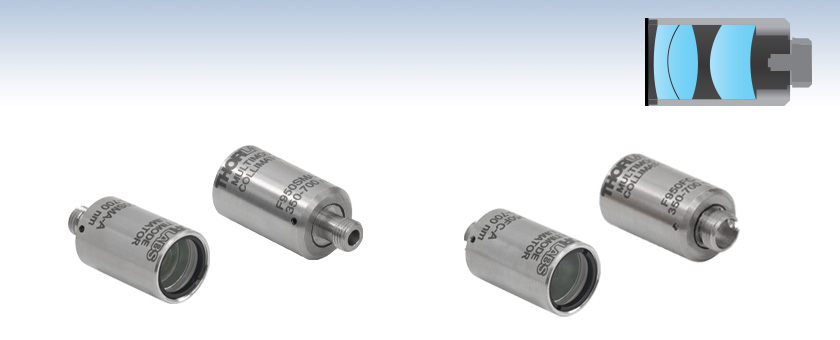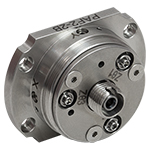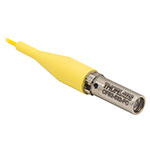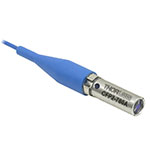High-NA Achromatic Collimators for Multimode Fibers

- Achromatic Performance Across Visible Spectrum
- AR Coated for 350 to 700 nm
- Options for FC/PC or SMA Connectors
- Ideal for Fiber Photometry Applications
F950SMA-A
SMA905 Multimode Collimator
Front
Front
Back
Back
F950FC-A
FC/PC Multimode Collimator
Our multimode collimators contain a cemented achromatic doublet and a meniscus lens.

Please Wait
| Click on the red Document icon next to the item numbers below to access the Zemax file download. Our entire Zemax Catalog is also available. |
Features
- High-NA Achromatic Collimators for Multimode Fiber
- Factory Aligned at 473 nm
- 9.9 mm Effective Focal Length
- Ø11 mm Clear Aperture
- Can be Used as a Coupler or Collimator
- Available with Either FC/PC 2.2 mm Wide Key or SMA905 Connectors
- Nonmagnetic Stainless Steel Housing
Thorlabs' High-NA Achromatic Collimators are designed for use with high-NA multimode fiber, and are therefore ideal for applications such as fiber photometry. These triplet collimators feature a meniscus lens and an achromatic doublet for high performance across the visible spectrum with low spherical abberation. The optics are broadband antireflection (AR) coated for 350 to 700 nm at the air-to-glass interfaces to minimize losses caused by surface reflections. Each collimator is factory aligned at 473 nm. The collimator housing includes either an FC/PC 2.2 mm wide key connector or an SMA905 port; typically, FC/PC collimators will offer better coupling efficiency.
The multimode collimators are compatible with the AD15F, AD15NT, and AD15F2 adapters for setups requiring SM1-threaded or Ø1" smooth bore compatibility; additional collimator mounting adapters are also available. When using these collimators as a free-space coupler, precise alignment is needed for good coupling efficiency. For autofluorescence and fiber photometry applications, our fluorescence filter cube is ideal for directing a free-space collimated beam towards fluorescence imaging filters. It is also possible to use a kinematic tip-and-tilt mount paired with an XYZ adjustable platform (such as our KM100V Kinematic V-Mount and MT3 (MT3/M) XYZ Translation Stage). Please note that using these collimators without a kinematic mount will introduce 1 dB of loss or more.
Thorlabs offers a wide variety of multimode patch cables that can be used with these collimators, including lightweight cables for optogenetics and low-autofluorescence cables for fiber photometry applications.
We also offer a line of aspheric fiber collimators, including our fixed collimators and our FiberPort adjustable collimation packages, that are well suited for use with a wide range of wavelengths. For our complete line of collimation and coupling options, please see the Collimator Guide tab.
| Item # | Alignment Wavelength |
Design Wavelengths |
Lens AR Coatinga | Beam Diameterb | Full-Angle Divergenceb |
Focal Lengthc |
Connector Style | NA | Ld |
|---|---|---|---|---|---|---|---|---|---|
| F950FC-A | 473 nm | 486 nm, 588 nm, 656 nm |
350 - 700 nm Ravg < 0.5% |
LED Source: 10.0 mm Laser Source: 4.5 mm |
0.5° | 9.9 mm | 2.2 mm Wide Key FC/PC | 0.54 | 28.6 mm (1.13") |
| F950SMA-A | SMA905 | 31.5 mm (1.24") |
Beam Diameter and Divergence
The 90/10 beam diameter and divergence were simulated for each of our F950 collimators utilizing a laser or LED source at various wavelengths.

Click to Enlarge
Typical 90/10 beam diameter from a high-NA, achromatic collimator with a multimode fiber-coupled laser input through 1 m of 0.22 NA multimode fiber; performance will be similar for fibers with NAs from 0.22 to 0.5.

Click to Enlarge
Typical 90/10 beam diameter from a high-NA, achromatic collimator with multimode fiber-coupled LED input through 1 m of 0.50 NA fiber.

Click to Enlarge
Typical divergence in a high-NA, achromatic collimator with multimode light sources input through 1 m of fiber; when using a laser as the input source, performance will be similar for fiber NAs from 0.22 to 0.5.
Insertion Loss and AR Coating Performance

Click to Enlarge
F950 collimators pair insertion loss measured using a SLS201 Light Source, an optical spectrum analyzer, and 0.39 NA, Ø200 µm core multimode optical fiber. The shaded region indicates the operating range of the collimator.

Click to Enlarge
Reflectance per surface of the broadband antireflection coating on the air-to-glass interfaces of each lens. The blue-shaded region denotes the reflection band for which the performance is guaranteed to meet the stated specifications. Performance outside the shaded region will vary from lot to lot and is not guaranteed.
| Posted Comments: | |
Andreas Seifahrt
(posted 2019-10-15 05:42:06.743) Thanks for adding this product. It would be great if you would consider offering them with a broader AR coating (400-1100nm) or even uncoated for broadband applications. YLohia
(posted 2019-10-16 09:39:35.0) Hello Andreas, thank you for your feedback. I have posted your request in our internal engineering forum for further consideration by our design engineers as a future product idea. user
(posted 2019-05-27 15:01:04.69) Is NA 0.54 as stated or 0.45? YLohia
(posted 2019-05-29 08:59:13.0) Hello, yes, the NA is 0.54. If you have further questions, please feel free to contact us at techsupport@thorlabs.com. |
Fiber Collimator Selection Guide
Click on the collimator type or photo to view more information about each type of collimator.
| Type | Description | |
|---|---|---|
| Fixed FC, APC, or SMA Fiber Collimators |  |
These fiber collimation packages are pre-aligned to collimate light from an FC/PC-, FC/APC-, or SMA-terminated fiber. Each collimation package is factory aligned to provide diffraction-limited performance for wavelengths ranging from 405 nm to 4.55 µm. Although it is possible to use the collimator at detuned wavelengths, they will only perform optimally at the design wavelength due to chromatic aberration, which causes the effective focal length of the aspheric lens to have a wavelength dependence. |
| Air-Spaced Doublet, Large Beam Collimators |  |
For large beam diameters (Ø5.3 - Ø8.5 mm), Thorlabs offers FC/APC, FC/PC, and SMA air-spaced doublet collimators. These collimation packages are pre-aligned at the factory to collimate a laser beam propagating from the tip of an FC or SMA-terminated fiber and provide diffraction-limited performance at the design wavelength. |
| Triplet Collimators |  |
Thorlabs' High Quality Triplet Fiber Collimation packages use air-spaced triplet lenses that offer superior beam quality performance when compared to aspheric lens collimators. The benefits of the low-aberration triplet design include an M2 term closer to 1 (Gaussian), less divergence, and less wavefront error. |
| Achromatic Collimators for Multimode Fiber |  |
Thorlabs' High-NA Achromatic Collimators pair a meniscus lens with an achromatic doublet for high performance across the visible spectrum with low spherical aberration. Designed for use with high-NA multimode fiber, these collimators are ideal for Optogenetics and Fiber Photometry applications. |
| Reflective Collimators |  |
Thorlabs' metallic-coated Reflective Collimators are based on a 90° off-axis parabolic mirror. Mirrors, unlike lenses, have a focal length that remains constant over a broad wavelength range. Due to this intrinsic property, a parabolic mirror collimator does not need to be adjusted to accommodate various wavelengths of light, making them ideal for use with polychromatic light. Our reflective collimators are ideal for collimating single mode fiber but are not recommended for coupling into single mode fiber. |
| FiberPorts |  |
These compact, ultra-stable FiberPort micropositioners provide an easy-to-use, stable platform for coupling light into and out of FC/PC, FC/APC, or SMA terminated optical fibers. It can be used with single mode, multimode, or PM fibers and can be mounted onto a post, stage, platform, or laser. The built-in aspheric or achromatic lens is available with five different AR coatings and has five degrees of alignment adjustment (3 translational and 2 pitch). The compact size and long-term alignment stability make the FiberPort an ideal solution for fiber coupling, collimation, or incorporation into OEM systems. |
| Adjustable Fiber Collimators |  |
These collimators are designed to connect onto the end of an FC/PC or FC/APC connector and contain an AR-coated aspheric lens. The distance between the aspheric lens and the tip of the fiber can be adjusted to compensate for focal length changes or to recollimate the beam at the wavelength and distance of interest. |
| Achromatic Fiber Collimators with Adjustable Focus |  |
Thorlabs' Achromatic Fiber Collimators with Adjustable Focus are designed with an effective focal length (EFL) of 20 mm, 40 mm, or 80 mm, have optical elements broadband AR coated for one of three wavelength ranges, and are available with FC/PC, FC/APC, or SMA905 connectors. A four-element, air-spaced lens design produces superior beam quality (M2 close to 1) and less wavefront error when compared to aspheric lens collimators. These collimators can be used for free-space coupling into a fiber, collimation of output from a fiber, or in pairs for collimator-to-collimator coupling over long distances, which allows the beam to be manipulated prior to entering the second collimator. |
| Zoom Fiber Collimators |  |
These collimators provide a variable focal length between 6 and 18 mm, while maintaining the collimation of the beam. As a result, the size of the beam can be changed without altering the collimation. This universal device saves time previously spent searching for the best suited fixed fiber collimator and has a very broad range of applications. They are offered with FC/PC, FC/APC, or SMA905 connectors with three different antireflection wavelength ranges to choose from. |
| Single Mode Pigtailed Collimators |  |
Our single mode pigtailed collimators come with one meter of fiber, consist of an AR-coated aspheric lens pre-aligned with respect to a fiber, and are collimated at one of eight wavelengths: 532 nm, 633 nm, 780 nm, 850 nm, 1030 nm, 1064 nm, 1310 nm, or 1550 nm. Although it is possible to use the collimator at any wavelength within the coating range, the coupling loss will increase as the wavelength is detuned from the design wavelength. |
| Polarization Maintaining Pigtailed Collimators |  |
Our polarization maintaining pigtailed collimators come with one meter of fiber, consist of an AR-coated aspheric lens pre-aligned with respect to a fiber, and are collimated at one of six wavelengths: 532 nm, 830 nm, 1030 nm, 1064 nm, 1310 nm, or 1550 nm. Custom wavelengths and connectors are available as well. A line is engraved along the outside of the housing that is parallel to the slow axis. As such, it can be used as a reference when polarized light is launched accordingly. Although it is possible to use the collimator at any wavelength within the coating range, the coupling loss will increase as the wavelength is detuned from the design wavelength. |
| GRIN Fiber Collimators |  |
Thorlabs offers gradient index (GRIN) fiber collimators that are aligned at a variety of wavelengths from 630 to 1550 nm and have either FC terminated, APC terminated, or unterminated fibers. Our GRIN collimators feature a Ø1.8 mm clear aperture, are AR-coated to ensure low back reflection into the fiber, and are coupled to standard single mode or graded-index multimode fibers. |
| GRIN Lenses |  |
These graded-index (GRIN) lenses are AR coated for applications at 630, 830, 1060, 1300, or 1560 nm that require light to propagate through one fiber, then through a free-space optical system, and finally back into another fiber. They are also useful for coupling light from laser diodes into fibers, coupling the output of a fiber into a detector, or collimating laser light. Our GRIN lenses are designed to be used with our Pigtailed Glass Ferrules and GRIN/Ferrule sleeves. |
 Products Home
Products Home













 High-NA Achromatic Collimators for Multimode Fiber
High-NA Achromatic Collimators for Multimode Fiber